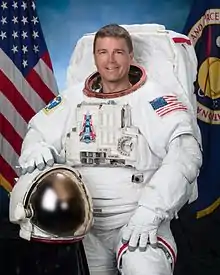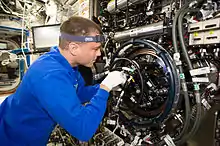Gregory R. Wiseman
Gregory Reid "Tonto" Wiseman (born November 11, 1975) is an American astronaut, engineer, and naval aviator.[1] Wiseman was selected in June 2009 as a member of the NASA Astronaut Group 20 and qualified as an astronaut in 2011. Wiseman took part in his first spaceflight as part of the crew of Expedition 40/41, which launched to the International Space Station on May 28, 2014, and returned on November 10, 2014.[2][3] Before joining NASA, Wiseman was a Naval Aviator and test pilot. Wiseman was the Deputy Chief of the Astronaut Office from June 2017, working under Chief Astronaut Patrick Forrester. On December 20, 2020 he was promoted to Chief of the Astronaut Office at NASA.
Reid Wiseman | |
|---|---|
 | |
| Born | November 11, 1975 |
| Status | Active |
| Nationality | United States |
| Occupation | Chief of the Astronaut Office |
| Awards | |
| Space career | |
| NASA astronaut | |
| Rank | |
Time in space | 165d 08h 01m |
| Selection | 2009 NASA Group |
Total EVAs | 2 |
Total EVA time | 12 hours, 47 minutes |
| Missions | Soyuz TMA-13M (Expedition 40/41) |
Mission insignia | |
Personal life and education
Reid Wiseman, callsign "Tonto", a native of Baltimore, Maryland, and a graduate of Dulaney High School in the suburb of Timonium, earned a degree in engineering from Rensselaer Polytechnic Institute.[4] He subsequently obtained a master's degree in systems engineering from Baltimore's Johns Hopkins University in 2006.[4] Wiseman is married to the former Carroll Taylor and has two daughters as of 2009.[5] He is also a go-cart driver.
Navy career
Reid was commissioned through the NROTC program following graduation from Rensselaer Polytechnic Institute in 1997 and reported to Naval Air Station Pensacola, Florida for flight training. He was designated a Naval Aviator in 1999 and reported to Fighter Squadron 101, Naval Air Station Oceana, Virginia, for transition to the F-14 Tomcat. Following his initial training, Reid was assigned to Fighter Squadron 31, also at NAS Oceana, and made two deployments to the Middle East supporting Operations Southern Watch, Enduring Freedom, and Iraqi Freedom.
During his second deployment in 2003, he was selected to attend the U.S. Naval Test Pilot School (NTPS) at Naval Air Station Patuxent River, Maryland with NTPS Class 125. Following graduation in June 2004, Reid was assigned as a Test Pilot and Project Officer at Air Test and Evaluation Squadron Two Three (VX-23) at NAS Patuxent River. At VX-23, Reid earned his M.S. degree and worked various flight test programs involving the F-35C Lightning II, F/A-18 Hornet weapons separation, Ship Suitability, and the T-45 Goshawk.
Following his tour at NAS Patuxent River, Reid reported to Carrier Air Wing Seventeen (CVW-17) as the Strike Operations Officer, where he completed a deployment around South America. From there he was assigned to Strike Fighter Squadron 103 at NAS Oceana, flying the F/A-18F Super Hornet. He was deployed to the Middle East when he was selected for Astronaut training. While serving with various U.S. Navy units, he was awarded the Air Medal with Combat V (five awards), the Navy and Marine Corps Commendation Medal with Combat V (four awards), the Navy and Marine Corps Achievement Medal, and various other campaign and service awards.
NASA career

On June 29, 2009, the National Aeronautics and Space Administration (NASA) announced Wiseman's selection as one of nine candidates from 3,500 applicants to begin astronaut training.[1][4] At the time, he was serving as a Lieutenant Commander in the U.S. Navy, flying as a pilot with Strike Fighter Squadron 103 on the aircraft carrier USS Dwight D. Eisenhower (CVN 69), and based at NAS Oceana, Virginia.[4] Wiseman said he often went to the U.S. Navy's "Blue Angels" shows as a youth, and developed the strong desire to become an astronaut when he saw a Space Shuttle launch in person in 2001.
Expedition 40/41
Wiseman was part of the Expedition 40/41 International Space Station crew. The mission was six months in duration and lasted from May to November 2014. Wiseman launched at 19:57 UTC on 28 May 2014.[2][3] The mission returned to Earth at 03:58 UTC on 10 November 2014.[6]
Chief of the Astronaut Office
Wiseman was selected to be the new Chief of the Astronaut Office on December 20, 2020, replacing Patrick Forrester. He previously served as Forrester's Deputy Chief of the Astronaut Office. [7]
References
![]() This article incorporates public domain material from websites or documents of the National Aeronautics and Space Administration.
This article incorporates public domain material from websites or documents of the National Aeronautics and Space Administration.
- NASA HQ (June 29, 2009). "NASA Selects New Astronauts for Future Space Exploration". NASA. Archived from the original on August 1, 2009. Retrieved June 29, 2009.
- "ESA astronaut Alexander Gerst to fly to Space Station in 2014". European Space Agency. September 18, 2011. Retrieved 24 November 2011.
- Clark, Stephen. "Mission Status Center". Spaceflight Now. Retrieved 28 May 2014.
- Roylance, Frank D. (June 30, 2009). "Gregory Wiseman picked to be astronaut". The Baltimore Sun. p. 4.
- NASA (September 2009). "Bio: Gregory R. Wiseman". NASA. Retrieved 2009-10-11.
- "Expedition 41 Lands Safely in Kazakhstan". NASA. Retrieved 10 November 2014.
- "NASA Names Astronaut Reid Wiseman New Chief of Astronaut Office". Jsc.nasa.gov. 2020-12-17. Retrieved 2021-01-22.
External links
| Wikimedia Commons has media related to Gregory R. Wiseman. |